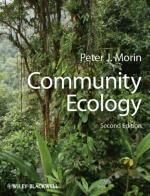|
This section contains 1,705 words (approx. 6 pages at 300 words per page) |

|
Community ecology is the study of the organization and functioning of communities of organisms. As populations of species interact with one another, they form biological communities. A community of organisms consists of all the interacting populations of the species living within a particular area or within a particular habitat. Community ecology also studies the relationships of the members of a community to their environment. Community ecology is usually subdivided according to habitat or biome. Typical habitats include forest, grassland, desert, and stream or lake environments.
The Trophic Pyramid
All biological communities have a similar structure called a trophic pyramid. Each pyramid contains four or five levels. Food energy is passed from one level to the next along a food chain. Since energy is lost to heat at each level in the pyramid, it takes many organisms at a given trophic level to support those in the...
|
This section contains 1,705 words (approx. 6 pages at 300 words per page) |

|


